Main Menu

Herbert Friedmann was an American ornithologist who worked at the Smithsonian Institute for over 30 years and served as the president of the American Ornithologists Union for 2. His work covered a wide range of topics, and he is noted, in particular, for his study of avian brood parasitism.
Alongside his scholarly research, Friedmann also took an interest in art and the symbolism of animals in the works of Old Masters, regarding the artists as early observers of nature. The result was his widely recognised book, The Symbolic Goldfinch: Its History and Significance in European Devotional Art.
While conducting research for the book, he found 486 devotional paintings containing a depiction of a goldfinch by 254 different artists, most of them Italian.
In almost all of them, the goldfinch occurs alongside the Madonna and Child. None are found in devotional paintings where Christ is an adult, and although depictions of the Annunciation were a popular theme in religious art, only 3 such pictures have been found containing the goldfinch.
The goldfinch is not mentioned in the Bible so why did this pretty songbird turn up in so many religious paintings?
The goldfinch is one of the most widespread birds of Europe and during the Renaissance period it would have been as familiar to those who lived in towns and cities as it was to those who lived in the country. It was a favourite household pet, not always kept in a cage for its singing, but tied to a long string and given to children who would watch as it flew about, unable to escape.
The birds were even taught to perform tricks such as open their feeding boxes, draw up food and water using a tiny bucket on a chain, ring bells, play dead, pull carts, and fire a miniature cannon.
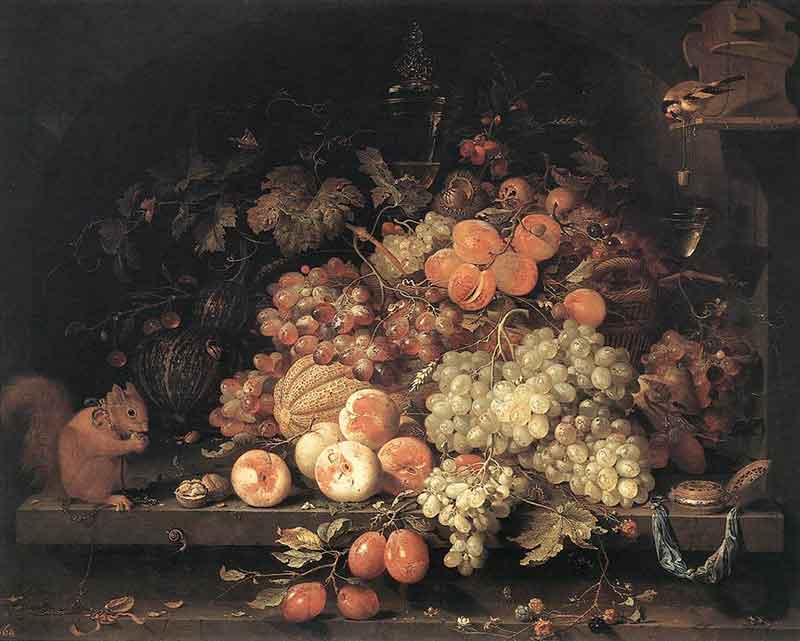
A goldfinch drawing water can be seen in this painting by Abraham Mignon, Fruit Still Life with Squirrel and Goldfinch, from about 1668, and its talent for doing so gave rise to an old country name for the goldfinch, the ‘draw-water’.
There are numerous portraits of children playing with goldfinches such as the one shown below. The Portrait of Giovanni de’ Medici as a Child is an oil painting by the Florentine artist Agnolo Bronzino painted in about 1545 and depicts the son of Cos Cosimo I de’ Medici, the Grand Duke of Tuscany clutching a goldfinch in his hand. The boy later became a cardinal in Santa Maria in Domnica at the age of just 16 but died only two years later from malaria.
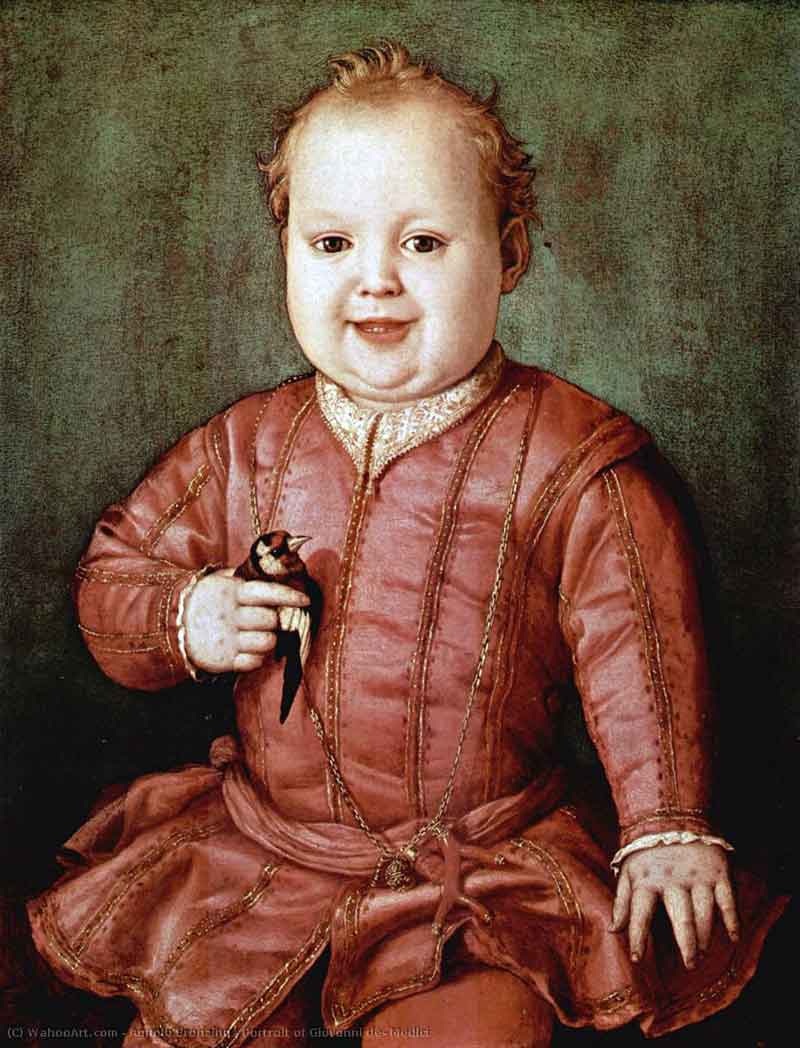
Another painting of a child with a goldfinch is much more playful. Vasily Tropinin was a Russian Romantic painter born as a serf in 1776. While he was meant to be studying the trade of a confectioner, he secretly attended drawing lessons at the Imperial Academy of Arts in St Petersburg.
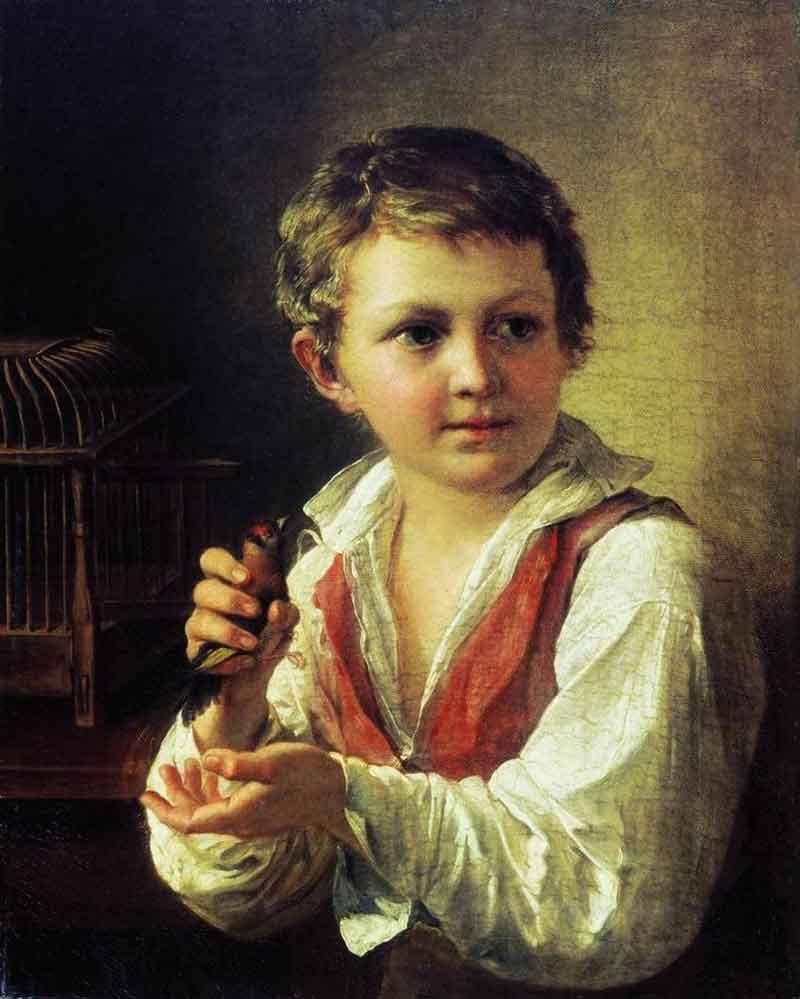
Eventually his owner, Count Morkov, allowed him to study art and commissioned him to copy works of European and Russian painters and produce portraits of the Morkov family. Over his lifetime Tropinin painted more than 3,000 portraits including nobles and officials but favoured working with children believing them to have genuine feelings and a pure soul.
To the left of the boy is the wooden cage in which the goldfinch would have lived, and Tropinin clearly shows how the boy holds onto the goldfinch very tightly but carefully so as not to hurt it.
Tragically, what appears to be the same little boy is depicted in another painting with the goldfinch lying dead in front of its cage.
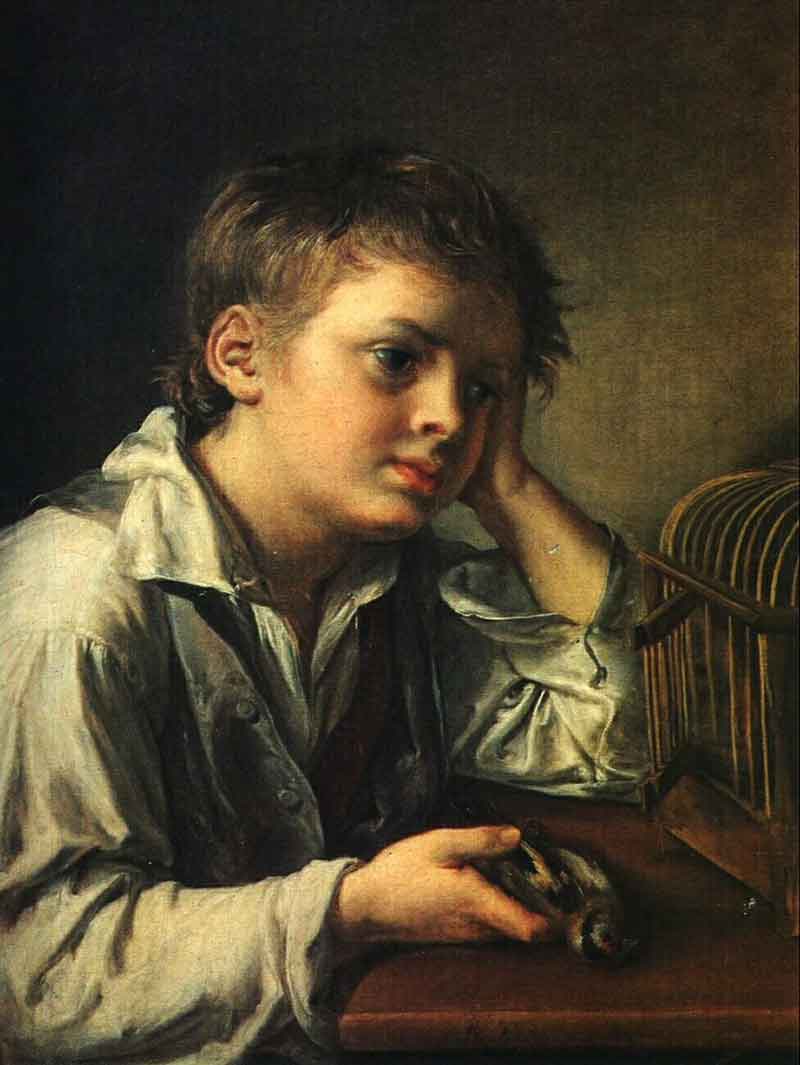
A goldfinch also turns up in Henriette’s Brown genre scene Enfant écrivant, or Girl Writing from 1870. Sophie de Bouteiller, who used the pseudonym Henriette Brown, the name of her maternal grandmother, to keep her professional and private lives separate is better known for her Orientalist art, particularly those of Eastern harems.
She depicted the harem as a place for social interaction for women rather than a space for the sexual pleasure of men, focussing on female labour and sexuality, and prioritising the female gaze.
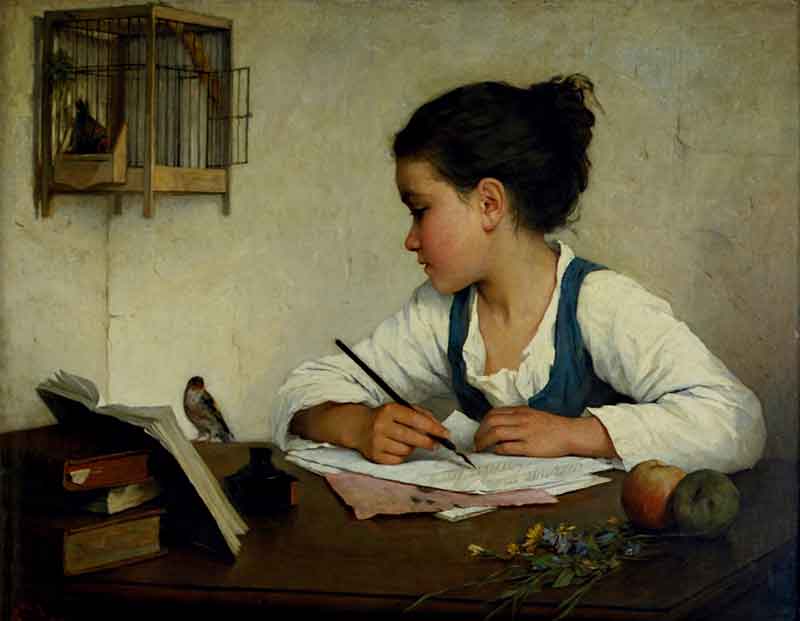
This painting is a fine example of her work portraying a little girl who is distracted by a goldfinch as she does her homework. Note the cage to the top left in which the bird would usually be confined.
With the familiarity of the goldfinch as a child’s pet, it makes sense that the infant Jesus would often be portrayed playing with a goldfinch.
But in religious art, the goldfinch had a much more symbolic meaning. Like the story of how the robin got its red breast, the red feathers on the goldfinch’s face were said to have arisen because the bird tried to pull a thorn from Christ’s crown during the crucifixion, and was stained red from a drop of his blood.
Another religious metaphor is that goldfinches eat the seeds from thistles and yet come to no harm from the thorns, in the same way that Christ was able to withstand the crown of thorns and create the Christian Church.
In Raphael’s Madonna del cardellino, or Madonna of the Goldfinch. Mary is shown with Christ and John the Baptist, both as babies. John holds a goldfinch in his hand with Christ reaching out to touch it.
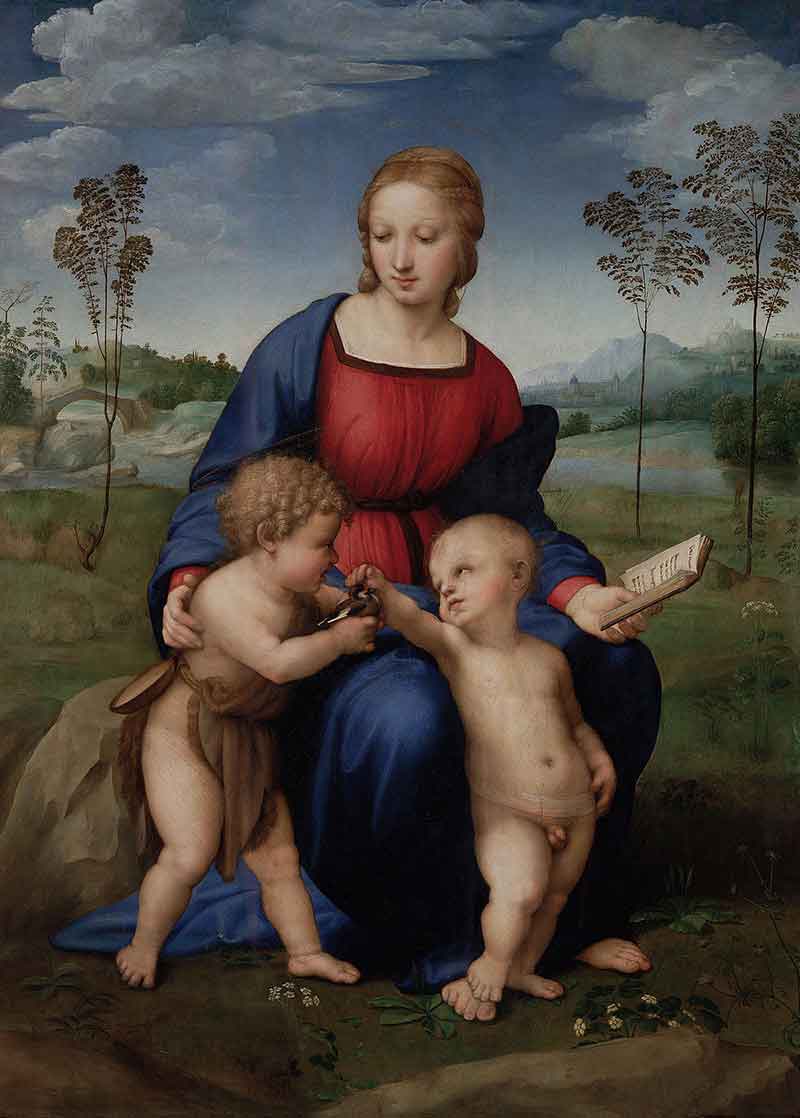
The oil painting, from about 1505, was a wedding gift from Raphael to his friend Lorenzo Nasi, a wealthy merchant from Florence. In 1548 Nasi’s house was destroyed by an earthquake and the painting broke into seventeen pieces. It was put back together but the seams were still visible until it was restored in 2002 to remove years of dirt that had degraded the painting’s colours and to fix the damage done by the earthquake. It now hangs in the Uffizi Gallery in the Historic Centre of Florence.
In the Taddei Tondo or The Virgin and Child with the Infant St John, a marble relief by Michelangelo, again John holds a goldfinch, representing The Passion, out to the baby Jesus, who turns away towards his mother, symbolically anticipating his future destiny.
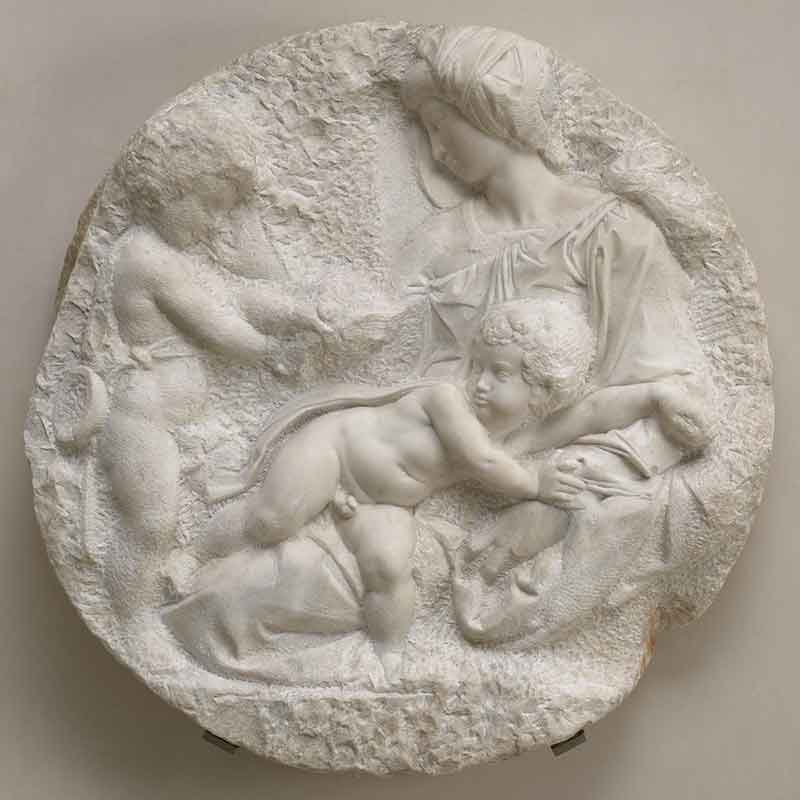
Like Christ, goldfinches were also thought to be able to cure disease, perhaps because of their association with Christ, but more likely because of the gold bars on their wings, a colour which since the Ancient Greeks, had been associated with healing.
It could also have been a contender for the caladrius, a non-descript bird that could heal the sick if they stared into its eyes. Certainly, in the medieval period, it was seen as a protector against the bubonic plague, and Leonardi de Vinci observed
“The gold-finch is a bird of which it is related that, when it is carried into the presence of a sick person, if the sick man is going to die, the bird turns away its head and never looks at him; but if the sick man is to be saved the bird never loses sight of him but is the cause of curing him of all his sickness.
“Like unto this is the love of virtue. It never looks at any vile or base thing, but rather clings always to pure and virtuous things and takes up its abode in a noble heart; as the birds do in green woods on flowery branches. And this Love shows itself more in adversity than in prosperity; as light does, which shines most where the place is darkest.”
As well as the symbolism there may be a simpler explanation of why goldfinches were portrayed in so many paintings of Christ. Showing Him playing with a familiar pet helped people identify with Him and reminded them that although He was the Son of God, he also lived and died as a child and man on earth.
Arguably, the most well-known painting of a goldfinch is that by Carel Fabritius. It is a simple picture of a bird perched on its feeding box against a white-washed wall.
The painting inspired Donna Tartt’s 2013 novel The Goldfinch and subsequent film of the same name in which a 13-year old boy walks off with the painting after surviving a terrorist bombing at the Metropolitan Museum of Art in New York that kills his mother. The painting reminds him of her, and he clings to it throughout his childhood before it draws him into the underworld of art.
It hangs in the Mauritshuis in The Hague and is the second most popular artwork in the museum after Johannes Vermeer’s The Girl with a Pearl Earring.
Fabritius was born in 1622 in Middenbeemster, a small village in Holland, the son of a painter and a schoolteacher. He was a pupil of Rembrandt and worked in his studio in Amsterdam. Of all of Rembrandt’s pupils, he was the only one to develop his own style shunning Rembrandt’s plain dark backgrounds and spot lit subjects for delicately lit portraits on light-coloured, textured backgrounds.
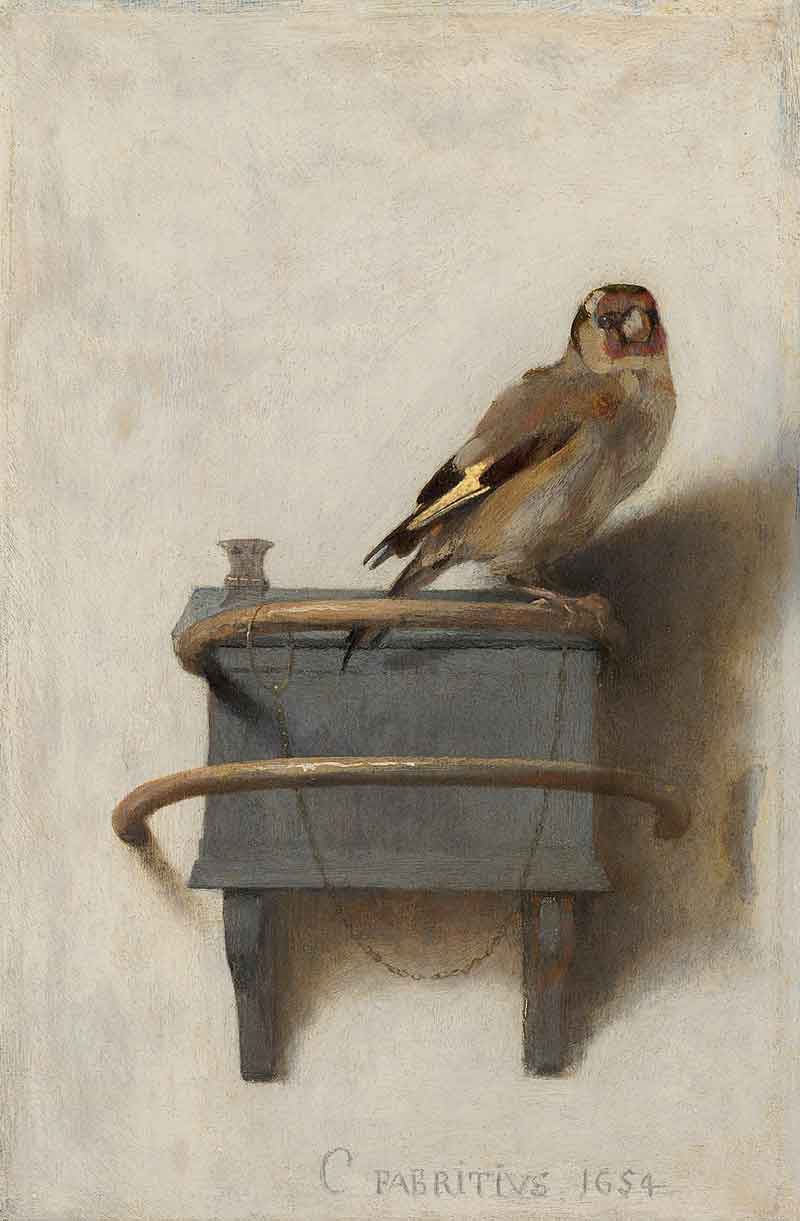
Many art scholars believe Fabritius was the link between Rembrandt and Vermeer and some suggest he may have taught the latter, although there is no hard evidence to support this.
As we have seen, goldfinches were often portrayed not just in religious art but in paintings of everyday life. What is so unusual about Fabritius’s painting is that it is a portrait of the bird by itself save for its chain and cage.
One theory is that the painting was used for a shop sign for the bookseller and wine merchant Cornelius de Putter, as a play on words for the Dutch for draw-water het puttertje.
Another theory suggests that it was part of a piece of furniture or another type of structure such as a cage for a painted bird. The panel on which it is painted is thicker than what would usually be used for a painting of this size, and it was originally covered with a gilded frame. The frame was later removed leaving only a greenish copper residue which Fabritius painted over and added the lower perch.
Fabritius was killed in the explosion at the Delft gunpower store, known as the Delft Thunderclap, in 1654, the same year he painted The Goldfinch. The explosion destroyed a quarter of the city including Fabritius’s studio and many of his paintings –the whereabouts of only 12 are known today. The Goldfinch was lost for more than two centuries before it was rediscovered in Brussels in the possession of a Dutch nobleman, Chevalier Joseph-Guillaume-Jean Camberlyn. It was purchased by the Mauritshuis in 1896.